Sailing on the open seas is one of the most exhilarating experiences. Feeling the wind in your hair and the sun on your face while you navigate through the waves cannot be matched.
However, learning to sail blue water can be daunting, especially for beginners.
It can be challenging to know where to start and what to expect. I know firsthand! Our first voyage on Britican was from Palma, Majorca, to Gibraltar, a three-day sail. I spent a great bulk of the time down below feeling green, thinking, ‘What have I got myself into?’
Due to time constraints, we were forced to leave Palma knowing a storm was imminent. On day two, we experienced gale-force winds. Fortunately, we had an experienced captain on board, helping to reduce our fears. Had he not explained that the boat was more than capable of the wind and weather, I might have thought we were in trouble.
So, this article was created to share some tips and tricks for learning to sail blue water.
From understanding the basics of sailing to choosing the right boat and equipment, I’ll cover various things you need to know to get started.
Whether a seasoned sailor or a beginner read on to discover how to navigate the open seas confidently.
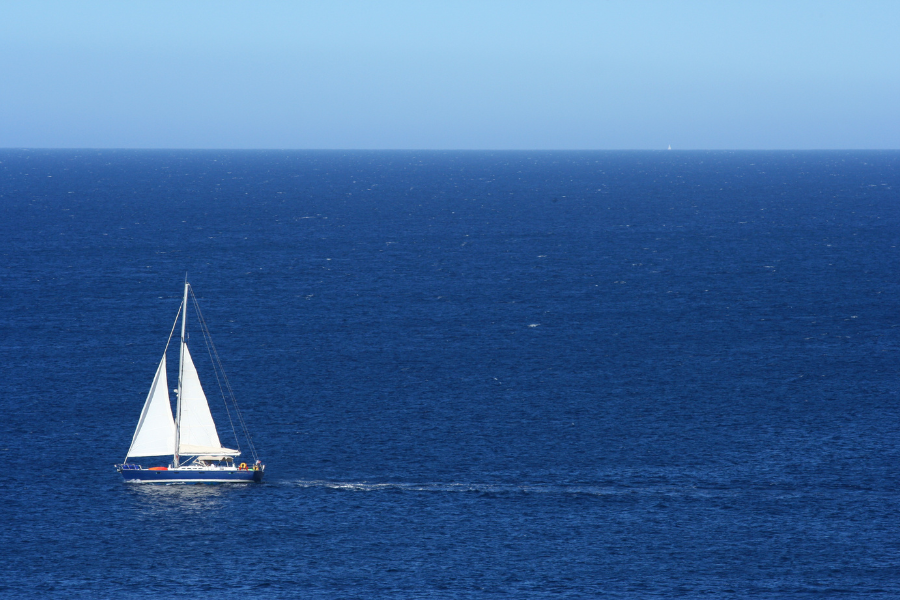
Essential skills for blue water sailing
Before you embark on a blue water sailing trip, it is vital to understand the essential skills required. Blue water sailing involves sailing in open waters, far from shore, often dealing with strong winds, high waves, and unpredictable weather conditions.
Here are some essential skills you should have:
1. Boat handling
Boat handling is, without doubt, one of the most critical skills required for blue water sailing. You must know how to steer the boat, trim the sails, and control the lines. A good sailor should be able to handle the boat in all kinds of conditions, including strong winds and rough seas.
If you haven’t been out in strong winds and big seas, hire an experienced captain to take you on your first passage. Nothing is more comforting than having someone experienced, by your side, telling you what’s normal and how to handle ‘normal,’ at sea.
2. Navigation
Navigating on the open seas is a crucial skill for a blue water sailor. You need to be able to read charts, plot a course on the plotter, and effectively use navigation instruments.
3. Safety
Safety is paramount when sailing on the open seas. You need to know how to handle emergencies, including man-overboard (MOB) situations, and be able to perform basic first aid. You should also be familiar with the safety equipment on board, including life jackets, flares, MOB kit, life raft, fire extinguishers, and EPIRBs.
Practicing MOB drills before a long open ocean voyage is an absolute must. To get a more comprehensive outline of the steps for becoming a blue water sailor, request my free guide, Sailing Cruiser Checklist: Get 160 Steps & Tips for Fast-Tracking Your Plans to Live the Sailing Life!
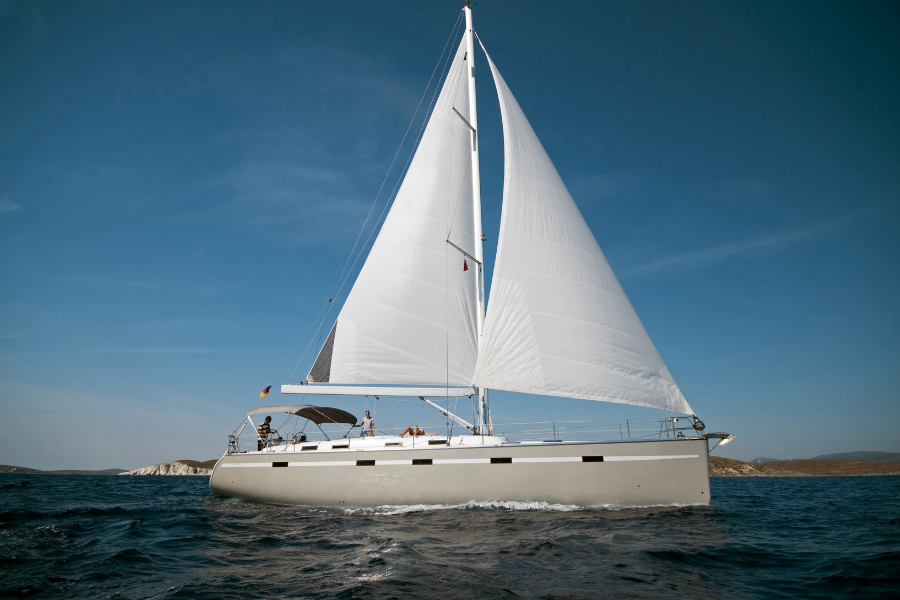
Preparing for a blue water sailing trip
Preparing for a blue water sailing trip is crucial, and there are several things you need to consider before setting sail. Here are some tips to help you prepare:
1. Plan your route
Planning your route is essential before embarking on a blue water sailing trip. You should consider factors such as weather patterns, currents, and tides. Planning your route will also help you estimate how much time you will need to complete the trip.
Before a passage, we use the PredictWind app to determine the best route and time to leave, ensuring we have the highest chance for comfort. Watch our video and read our article 7 Steps to Passage Planning for a full run-down on how we plan a passage.
2. Check the weather forecast
Checking the weather forecast is essential when preparing for a blue water sailing trip. You should check the forecast regularly and plan your route accordingly. You should also be prepared for changes in the weather, as conditions can change quickly on the open seas.
We start watching the weather two weeks before we set off on a long voyage. We use a variety of weather-forecasting apps depending on where in the world we are. Windy.com has been a favorite for years.
3. Stock up on supplies
When sailing on the open seas, you need to be self-sufficient. You must stock up on supplies, including food, water, and fuel. You should also ensure that you have spare parts and tools on board for mechanical issues.
I usually make ready meals and meal kits to reduce the cooking to simple tasks like heating and serving. To get an idea of ready meals and meal kits, grab a copy of our Long Sailing Passage Preparation Checklist.
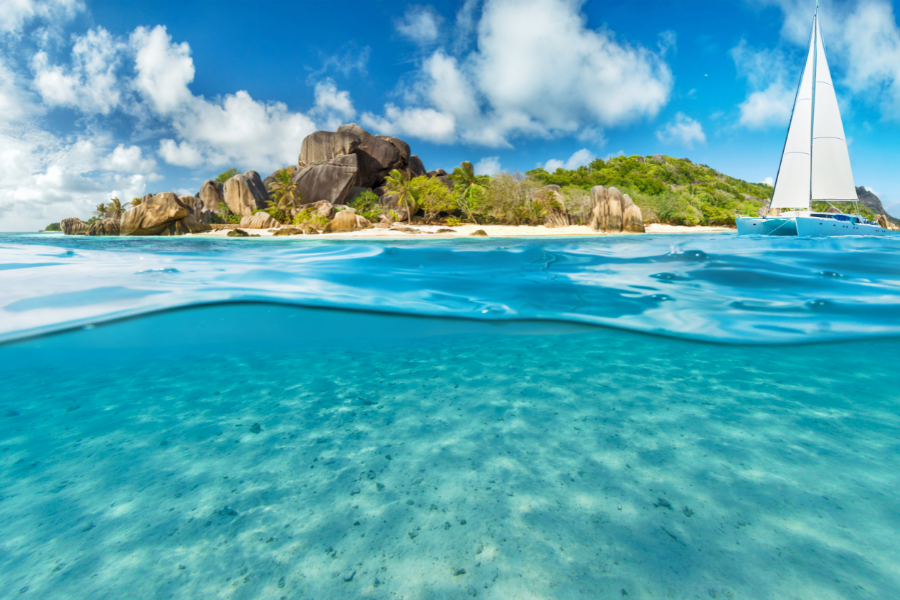
Understanding weather patterns
Understanding weather patterns is crucial when sailing on the open seas. Weather can change quickly, and you must be prepared for any eventuality. Here are some tips to help you understand weather patterns:
1. Read the clouds
Reading the clouds can give you a good indication of the weather conditions to come. For example, you can expect rain and thunderstorms if you see dark, heavy clouds. On the other hand, if you see high, thin clouds, it usually means good weather is on the way.
Our daughter, Sienna, would see a plane trail high in the sky and say, ‘It’s going to be good weather today!’ That’s one of the things I love about sailing – you become more knowledgeable about what nature can tell you.
Squalls are usually easy to see as they look like a wall of clouds stretching from the sky to the sea. However, it’s essential to know that the wind will come first, before the rain, and it usually hits the boat at a different angle than where the squall is located.
2. Watch the wind
Wind direction and strength can give you a clue about the weather. We’ve been caught out a few times when a front came through before we could reduce our sails. Whenever we get over 30 knots of winds, we reduce the headsail, and if the wind gets much more substantial, we pull the whole sail in.
When squalls hit, they don’t last long. Knowing how to reduce your sails, or spill wind from your sails, before and even during high winds is essential.
3. Monitor the barometer
Monitoring the barometer is an excellent way to keep track of changes in the weather. A falling barometer indicates a storm is coming, while a rising barometer indicates improving weather.
We check the barometer and note it in our log book every three hours. If we see a significant drop, we know bad weather is approaching. If you notice a rapid decrease in pressure, it’s a strong indication that you should prepare for adverse weather conditions such as high winds, heavy rainfall, or thunderstorms.
This advanced warning can give you the opportunity to make necessary adjustments to your sailing plans, such as reducing sail area, securing loose items, or seeking a safe harbor.
Also, changes in barometric pressure can influence the height of tides, which can be crucial for safe navigation in shallow waters or areas with tidal currents. A falling barometric pressure tends to raise the water level, leading to higher tides, while rising pressure can lower the water level and result in lower tides.
By tracking these pressure changes, you can anticipate the corresponding tidal effects and plan your sailing routes accordingly, avoiding potential hazards like shallow areas or submerged obstacles.
To get a more comprehensive outline of the steps for becoming a blue water sailor, request my free guide, Sailing Cruiser Checklist: Get 160 Steps & Tips for Fast-Tracking Your Plans to Live the Sailing Life!
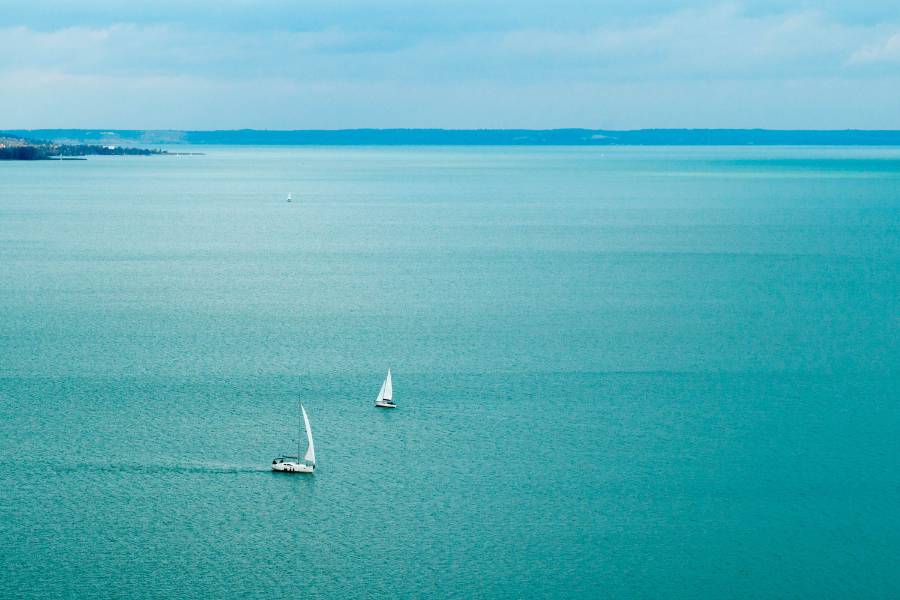
Navigation techniques for blue water sailing
Navigation techniques are essential when sailing on the open seas. Here are some tips to help you navigate:
1. Use your plotter and have a backup
Before upgrading our navigation equipment, it wasn’t uncommon for our plotters to reboot and even turn off on us. Having a GPS-enabled iPad or similar works as a great backup.
2. Use navigation instruments
Navigation instruments like a compass and GPS are essential for navigating the open seas. You should know how to use these instruments and know their limitations.
When we left Gran Canaria across the Atlantic Ocean, our instruments told us we were headed to Africa (the wrong way)! Interestingly, a crew member stowed something magnetic near our compass, causing havoc on our systems. Anything near the compass will cause issues, so keep that in mind.
3. Learn celestial navigation
Celestial navigation involves using the stars to navigate. While GPS is now the most common navigation method, it is still fun to learn the basics of celestial navigation in case of any issues with your GPS. To get a more comprehensive outline of the steps for becoming a blue water sailor, request my free guide, Sailing Cruiser Checklist: Get 160 Steps & Tips for Fast-Tracking Your Plans to Live the Sailing Life!
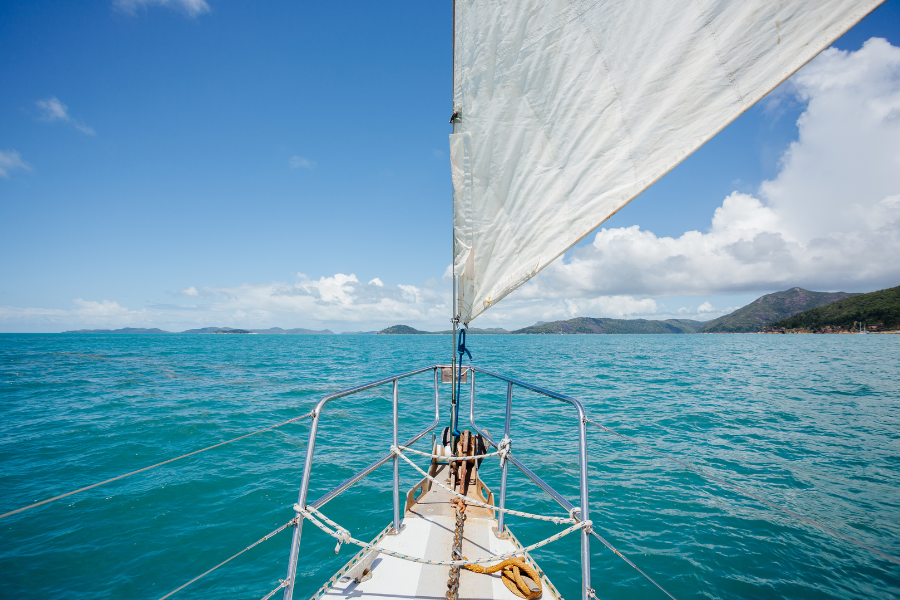
Communication on board a sailing vessel
Communication on board a sailing vessel is vital for safety and efficiency. Here are some tips for effective communication:
1. Use standard terminology
Using standard terminology is essential for clear communication on board. Ensure everyone on board understands the terminology and that it is used consistently. I know it’s a huge learning curve, as every item on a boat has a name that’s not necessarily logical. There are sheets and halyards, port and starboard, bow and aft. The list goes on.
For some tips and tricks on key sailing terms to remember, read: Sailing Terms You Need to Know.
2. Communicate your passage plan
Make sure that everyone on board knows the passage plan. Before every passage, we brief everyone about the passage plan and provide a boat briefing to new guests. Our boat briefing is a two-page checklist incorporating the key things people need to know about safety and how the boat and its systems work.
Get a copy of our boat briefing checklist within our Checklists for Sailors guide.
Before leaving port, we also give our plan to a few people on land so they know where we’re going and when we plan on arriving. We ensure the person listed as our emergency contact on our EPIRB also has our plan.
3. Practice effective communication
Effective communication involves not only speaking clearly but also listening actively. Make sure that everyone on board can communicate effectively and that everyone listens to each other.
Further, it’s so crucial for everyone on board to understand how to use the VHF Radio and any other communication systems effectively. Ideally, you want everyone on board to be able to understand an emergency and know precisely what to do. A big part of getting help is effectively using communication systems.
Check out our VHF Radio Checklist & Templates guide providing user instructions and exact wording necessary for every emergency call here: VHF Radio Checklists & Templates.
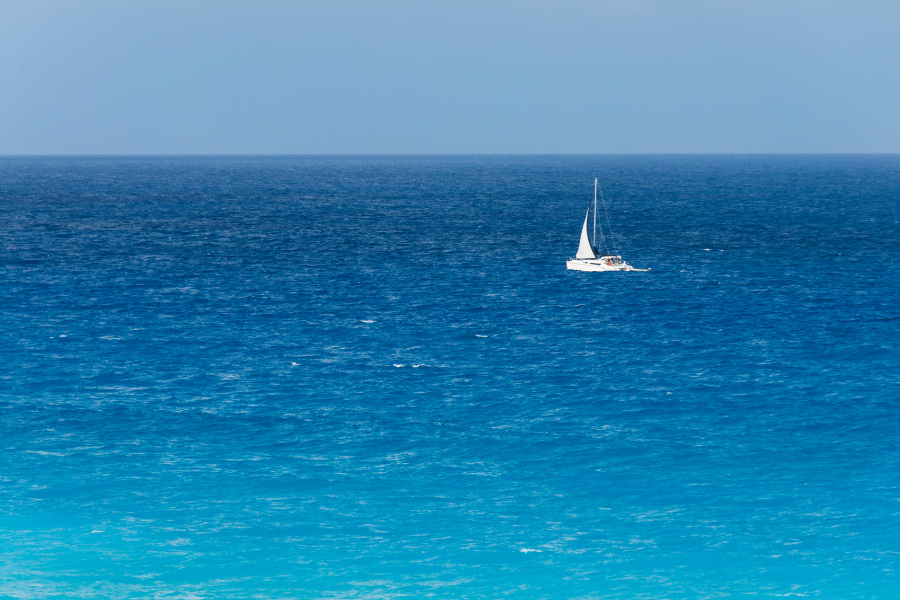
Safety tips for blue water sailing
Safety is paramount when sailing on the open seas. Here are some safety tips to help you stay safe:
1. Wear a life jacket
Wearing a life jacket is essential when sailing on the open seas. Ensure that everyone on board has a properly fitted life jacket and wears them when required. All our life jackets have a number on them so people can quickly find their jacket. We always wear our life jackets in heavy weather, during storms, and at night. We also wear personal EPIRBS so that if someone falls overboard, we can track them back to their location.
As part of our Boat Briefing, we also tell our guests that no one is allowed to pee off the back of the boat on passage. A large portion of men found drowned at sea are found floating with their flies down.
2. Have a boat safety manual
A boat safety manual containing safety equipment locations, user instructions, and procedures is essential in emergencies. Ensure that everyone reviews the manual and that all safety equipment works correctly. Further, practice common boat safety drills such as Man Overboard, losing steering, fire, and taking on water.
Get a copy of our customizable boat safety manual here: Boat Safety Course & Manual.
3. Stay alert
Staying alert and aware of your surroundings is vital for safety when sailing on the open seas. Keep a lookout for other boats, wildlife, and changes in the weather. With modern technology, it’s easy to think that it’s okay to put alarms on for other vessels or even wildlife; however, having a pair of eyes on deck is essential.
We never leave the cockpit unattended. At times during night sails, we do sometimes struggle to stay away. We set our alarm for 15 minutes and take cat naps between having a look around. It’s not perfect, but it’s better than passing out and not waking up for hours! To get a more comprehensive outline of the steps for becoming a blue water sailor, request my free guide, Sailing Cruiser Checklist: Get 160 Steps & Tips for Fast-Tracking Your Plans to Live the Sailing Life!
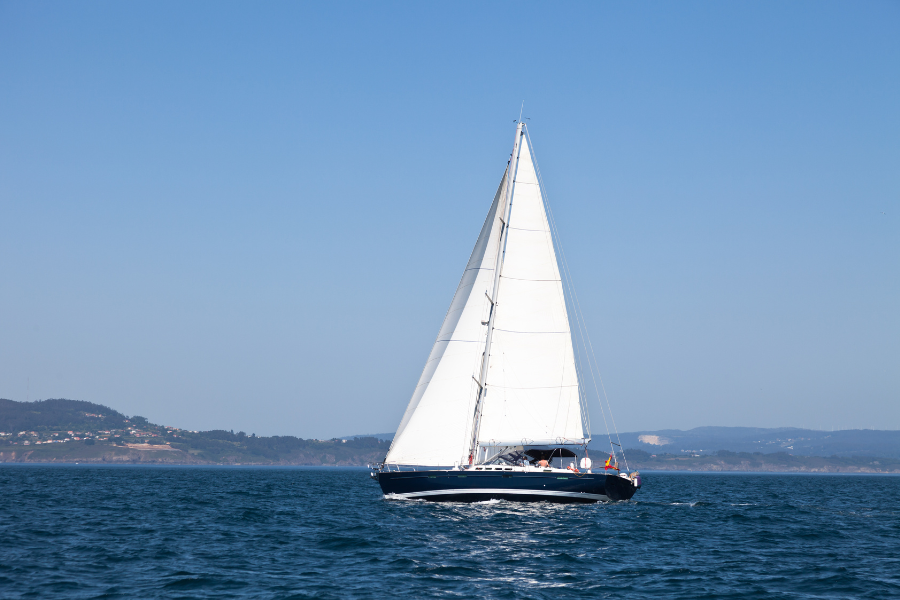
Common challenges encountered while blue water sailing
Blue water sailing can present many challenges, and it is important to be prepared. Here are some common challenges you may encounter:
1. Rough weather
Rough weather is one of the biggest challenges when sailing on the open seas. Ensure you are prepared for all kinds of weather and know how to handle the boat in rough seas.
I can’t write this enough…when you first get your boat, have an experienced captain spend a few days to a week with you on the water. Ideally, have a captain join you on your first long passage. By doing this, you’ll learn invaluable lessons.
You’ll learn what to do when a squall passes through, what’s good/not good when evaluating a possible day to leave port, how to monitor your systems and progress throughout the passage, and much more.
When you get out into the sea, it can be scary, and nothing is more calming than having someone with experience tell you that everything is okay. When doing our Sailing Experience Weeks, our guests often asked us if the waves/swell was average, and we’d usually tell them it was calm!
A big issue is that a couple leaves port not knowing what the open ocean is like. They get into bad weather or big seas, and one partner says, ‘No Way! I’m out of here.’ Had they first experienced the open ocean with a professional, any fears would have been eliminated.
2. Equipment failure
Equipment failure can happen at any time when sailing on the open seas. Ensure you have spare parts and tools on board and know how to perform basic repairs.
Critical spares for the engine(s) are paramount. You’ll want to ensure you have extra oil and fuel filters. We go to remote places, so we can do a full engine service 3x and carry a spare fuel lift pump, hoses, claps, spark plugs, etc. We even have a spare starter engine!
Your engine will have a suggested spare part kit that you can purchase. Check that out. Also, consider sail repair kits, rigging fixes, bungs for all thru-holes, and head servicing kits. If you want a comprehensive checklist for what to carry as a sailing cruiser, check out our Checklists for Sailors guide.
3. Navigation issues
Navigation issues can be a challenge, especially if your GPS fails. Make sure you know how to navigate using charts and celestial navigation in case of any issues with your GPS.
In the ten years of sailing that we’ve done, our systems have gone down a few times. In most cases, we were near land and could use line-of-sight to get to where we wanted to go. Before any voyage, we would have studied our entry plan, knowing how to enter the destination location avoiding obstructions. To get a more comprehensive outline of the steps for becoming a blue water sailor, request my free guide, Sailing Cruiser Checklist: Get 160 Steps & Tips for Fast-Tracking Your Plans to Live the Sailing Life!
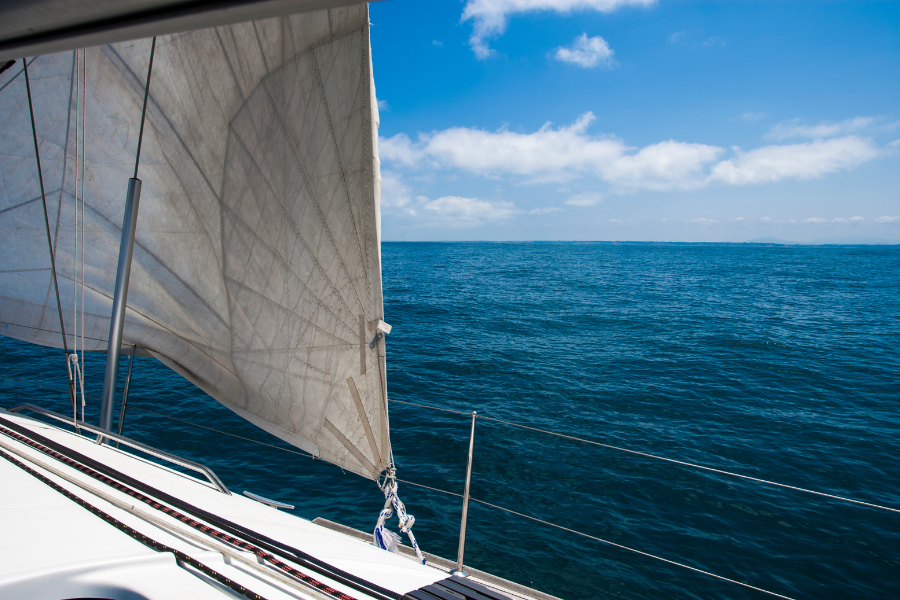
Resources for learning blue water sailing
Learning blue water sailing can be daunting, but many resources are available to help you. We often get asked if people have to start young to be able to do it. We didn’t start sailing full-time until we were in our 40s/50s, and until then, we did one sailing vacation (week-long) every year. We had very little prior knowledge.
And once you get out sailing, you’ll find that there are couples in their 60s that only recently learned how to sail. Age is not so much of an issue. Physical ability, however, is very important. Being on a boat requires excellent balance, strength, and dexterity.
Here are some resources to get started:
1. Sailing schools
Sailing schools offer courses for all levels of sailors, from beginners to advanced. These courses can teach you everything from the basics of sailing to advanced navigation techniques. It’s worth doing ASA or RYA courses to get the basics when starting. The instructors will teach you the names of everything, how a boat sails, and provide lessons on plotting courses on a chart.
It’s all great information and experience; however, very basic. Further, schools spend a high amount of time teaching ancient navigation practices. No boater uses charts anymore unless they want to feel nostalgic.
Instructors say that it’s essential to know how to use a chart if your system goes down, but if you’re sailing oceans, chances are you won’t have the money or space to hold all the charts you’d need.
So…yes, it’s important to know the ancient ways of planning a passage by hand. But to save time, increase accuracy, and have the best information at your fingertips, using modern technology is the norm.
That’s why we suggest that people get their ASA/RYA qualifications and then do a week with an experienced captain to learn how sailors in modern times plan passages. Also, check out our week-long fully immersive sailing experiences in the Caribbean here: Sailing Experience Weeks.
2. Online courses
Online courses are a great way to learn at your own pace. There are many online courses available that cover all aspects of blue water sailing. Both ASA and RYA offer the theoretical part of their courses online.
3. Books and videos
Books and videos are great resources for learning blue water sailing. There are many books and videos available that cover everything from boat handling to navigation.
To get a more comprehensive outline of the steps for becoming a blue water sailor, request my free guide, Sailing Cruiser Checklist: Get 160 Steps & Tips for Fast-Tracking Your Plans to Live the Sailing Life!
Learning to sail blue water can be daunting, but it can be one of the most rewarding experiences with the right skills and knowledge.
From understanding the basics of sailing, choosing the right boat and equipment, and navigating the open seas confidently, this article has covered some things you need to know to get started. Whether you’re a seasoned sailor or a beginner, we hope this guide has helped you confidently navigate the open seas.
Good morning to you Kim and Simon, or whatever time zone you are in 🙂
I do follow your publishing since some years and i put this, your facebook article, too, into ‘my’ facebook.
Hope, it will be successful.
Hope, too, that the ‘right’ people will read and buy it. The ‘right’ people are those, who think they just buy a boat and sail along and the rest is ‘learning by doing’.
This does not work at sea … and I mostly had to help people who turned suddenly from landlubbers into ‘want to be sailors’ without any practice, learning and often without any idea of sea, sailing and the conditions of it.
All the best,
happy sailing
Klaus
Thank you for the feedback Klaus. Smiles, Kiim